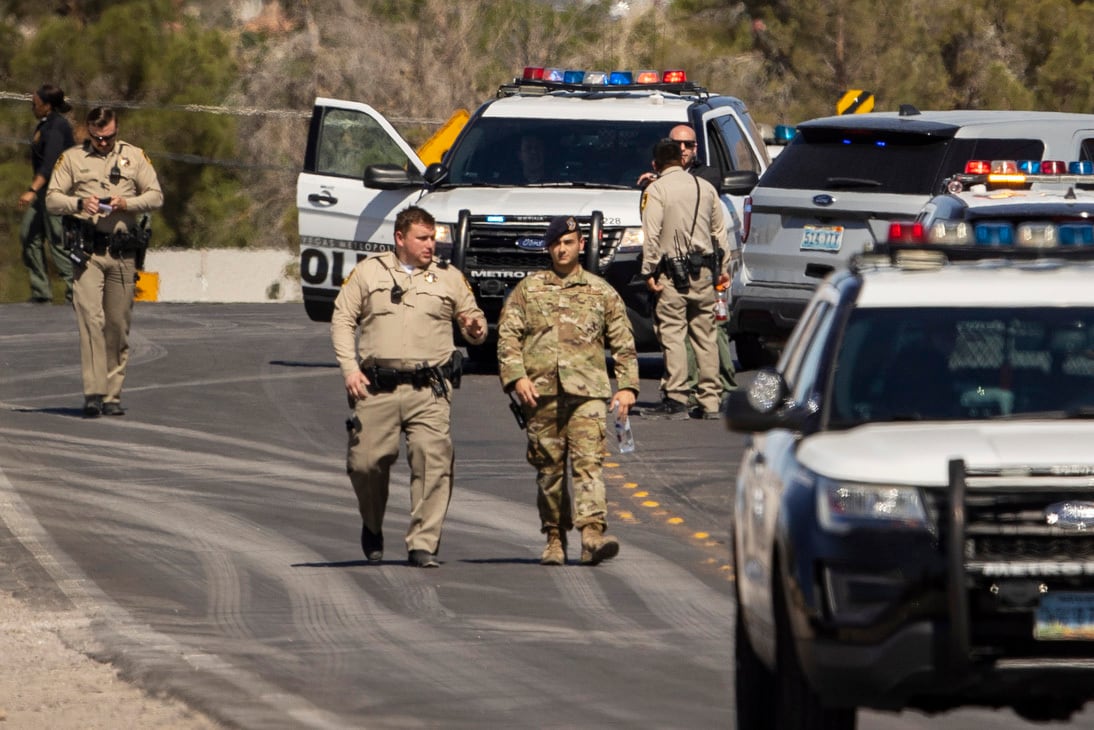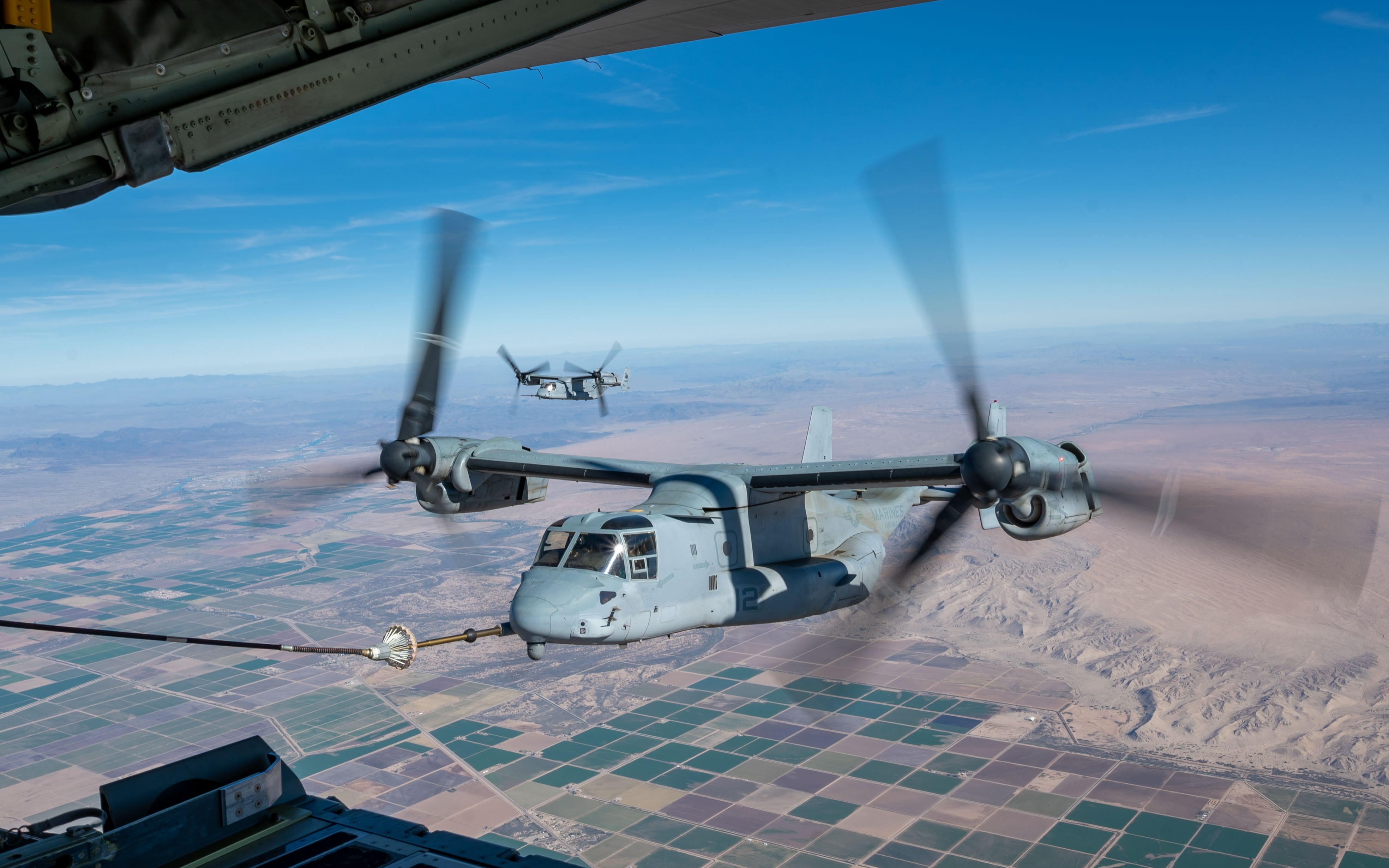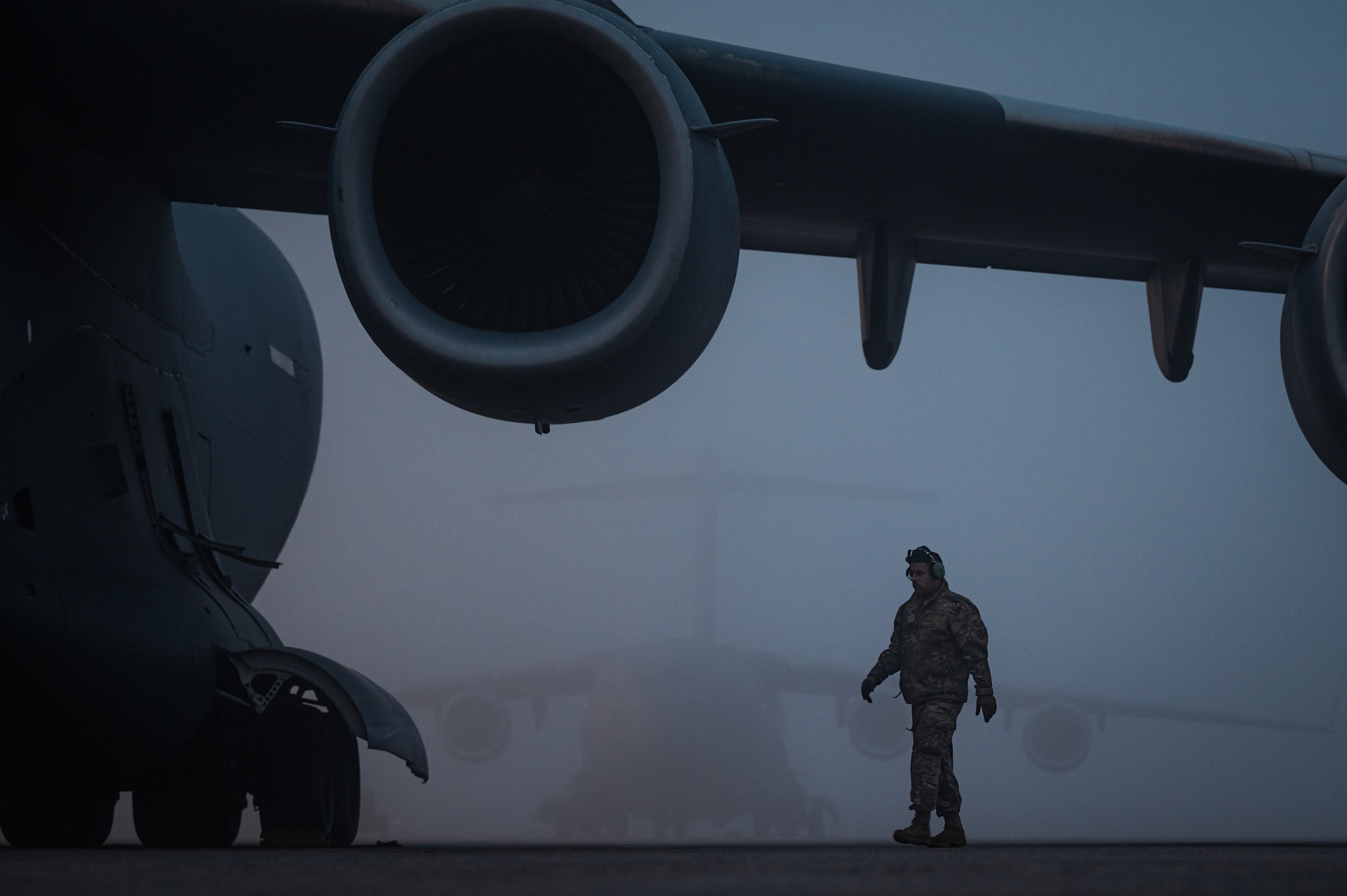Two people died and 10 aircraft were destroyed in aviation-related mishaps in fiscal year 2023 as the Air Force’s most serious accidents hit a five-year high.
The latest milestone was driven by a jump in the deadliest and most expensive accidents, most of which occurred in flight. But an Air Force Times analysis of the service’s safety data found that even as the number of airborne mishaps has plateaued, a spike in maintenance-related incidents has cost the Air Force millions of dollars and — increasingly often — injured airmen on the job as well.
RELATED

As of April 1, the service had recorded 75 major non-combat mishaps in FY23, which ran from Oct. 1, 2022, to Sept. 30, 2023. That’s up from 67 in the year prior, and from 63 in FY19, according to the Air Force Safety Center.
Ground accidents comprised more than 28% of those mishaps in FY23 — up from 19% two years earlier.
The increase in Class A and B incidents comes as the Air Force juggles a decades-old inventory with operational demands and a stretched-thin maintainer corps, even as efforts ramp up across the Defense Department to curb the number of accidents involving military vehicles.
“Every mishap is different, and each is investigated individually and thoroughly to identify causal factors in efforts to prevent similar mishaps,” Maj. Gen. Sean Choquette, the Air Force’s safety chief, told Air Force Times. “Our goal is to understand the associated hazards, and to eliminate or mitigate them to [the] greatest extent possible in both training and combat operations.”

Key findings
From nose gear failures to destructive debris, the Air Force saw 52 flight mishaps, 21 ground mishaps — nearly double those in each of the previous two years — and two “flight-related” mishaps among Class A and B incidents in FY23, the Safety Center said April 1. Figures can change as investigations progress after the fiscal year ends.
MQ-9 Reaper drones logged 10 mishaps in FY23, more than any other airframe, Air Force data showed. The F-22 Raptor fighter led manned aircraft in mishaps at nine accidents, followed by the CV-22 Osprey tiltrotor transport aircraft and C-17 Globemaster III airlifters at seven incidents each.
MQ-9s, C-17s and the F-35 Lightning II fighter saw the highest number of the most severe events, known as Class A mishaps. The Air Force logged 29 Class A mishaps in 2023, up from 24 the previous year; the service averaged almost 27 annually over the last five fiscal years.
Class A accidents involve a death or permanent total disability, destruction of a U.S. military aircraft, damages of more than $2.5 million, or a combination of those three criteria.
Less-serious Class B mishaps, which can also be life-altering, rose from 43 in 2022 to 46 in 2023. The service has averaged around 41 Class B accidents in the past five years.
Those incidents cause between $600,000 and $2.5 million in damages, a permanent partial disability, inpatient hospitalization of three or more personnel, or a combination of those factors.

Human toll
FY23 fatalities included Stephanie Rodriguez-Cosme, a 32-year-old test engineer and contractor who was struck by an MQ-9′s whirring propeller during ground testing, as well as a civilian employee of the Missile Defense Agency who died after experiencing health problems while flying on a C-17.
Neither death was disclosed at the time of the incident; the Air Force allows local commanders to decide whether to publicly announce a fatality.
An Air Force investigation, the results of which were released April 5, found that Cosme was incorrectly trained on taking data readings from the drone with its engine running, and wasn’t paying close attention as she approached the aircraft. The investigation report also cited a lack of clear communication between contractors and ground support personnel, and said they were rushed because of previous delays.
The service declined to provide more details about the C-17 mishap.
The Air Force typically records fewer than six mishap-related deaths each year. But the human toll of aviation accidents isn’t limited to fatalities:
- On Feb. 27, a contractor was trapped under a T-38 Talon training jet when its nose gear collapsed during ground maintenance at Holloman Air Force Base, New Mexico. Others freed the maintainer, who was airlifted to a hospital and spent several days in treatment for multiple broken bones and other injuries.
- On May 15, a pilot was treated for minor injuries after an F-15D Eagle assigned to the Oregon Air National Guard’s 173rd Fighter Wing experienced an in-flight emergency and skidded off the runway, landing in a canal.
- On July 31, a U.S. Air Force Academy cadet landed in the hospital for more than three months after becoming entangled during freefall parachute training. The academy stopped flying for the day and paused parachute training until the next class, which began in October, said Sean Worrell, a spokesperson for the 12th Flying Training Wing. The accident did not spur any changes in policy or procedures, Worrell said.
- On Aug. 17, a maintainer was injured by debris when the propeller from one CV-22 Osprey struck another that was parked. Propellers on both aircraft were damaged.
- On Aug. 22, an Osprey lost control and hit the ground, damaging its belly and injuring a crew member upon impact.
An Air Force Safety Center spokesperson called maintainer injury the top aviation mishap trend that arose in FY23, including a 16% increase in head injuries. The service has tried to curb the number of head injuries through bump caps — lightweight plastic hats or inserts that can lessen the force of impacts — but is reassessing that strategy.
While the Safety Center declined to specify what steps it’s taking to keep airmen safe at work, it said it surveys how airmen perceive the amount of risk within their squadrons. Better scores on those surveys can reflect fewer workplace injuries.
“Commanders are debriefed on mission areas that are both performing well and those areas needing attention,” the organization said. “This helps command teams to target higher-risk areas, efficiently manage resources and conduct additional training.”
Major crashes
Meanwhile, manned and unmanned aircraft alike suffered higher rates of the worst accidents.
For manned aircraft, the service logged about 1.18 Class A mishaps per 100,000 flying hours — the highest since FY20, when the rate spiked to 1.34 accidents in the same timespan, according to the Air Force. For unmanned aircraft, that rate hit 2.91 incidents per 100,000 flying hours, the most since FY16, when the service saw 3.58 mishaps per 100,000 flight hours. The service did not provide its total number of flight hours in FY23 by press time.
The Air Force also saw 10 aircraft totaled, at a rate of 0.58 per 100,000 flying hours. That’s an increase from six destroyed aircraft in FY22, and the most since 2020, when 14 airframes were ruined.
Still, Class B mishap rates among manned aircraft fell from 2.14 to 1.95 accidents per 100,000 flight hours between FY22 and FY23. The rate for unmanned aircraft also fell from 0.44 to 0.23 accidents per 100,000 hours in the same time frame.
Aircraft destroyed last year included six MQ-9s, which suffered from a variety of problems ranging from engine and electrical system failures to loss of control. Drones are often seen as more dispensible because they are cheaper to replace than manned aircraft and don’t have a human life in the cockpit.

The service also lost three manned jets:
- In October 2022, an F-35A crashed at Hill Air Force Base, Utah, when turbulence confused its software.
- In November 2022, a T-38C Talon training jet crashed in Mississippi after a bird strike shattered its windshield and broke its engines.
- In May 2023, an F-16 Fighting Falcon assigned to the 8th Fighter Wing at South Korea’s Kunsan Air Base crashed in an agricultural area about a dozen miles from base during a training sortie. Safety Center data does not indicate what caused that accident.
Pilots in each of those mishaps ejected safely.
More recently, a UH-1N Huey from the 37th Helicopter Squadron, based at F.E. Warren AFB, Wyoming, crashed and flipped over in a hard landing at Cheyenne Regional Airport during routine training on Aug. 30. Three crew members were treated and released from a local hospital that day, the Air Force said.
Engine woes, frequent FOD
Engine problems were among the most frequent culprits behind mishaps across multiple fleets. The aging C-17 led the way with five engine-related incidents, four of which occurred while in flight.
1st Lt. Peyton Craven, a spokesperson for Air Mobility Command, didn’t respond to a question about the C-17′s engine issues but blamed the problems on old, overworked aircraft. While the command totaled 12 accidents in FY23, it saw the lowest mishap rate in five years, and a 13% drop from the previous year, Craven said.
“The majority of the mishap causes are consistent with what we would expect from aging airframes and flight hour totals,” Craven said.
RELATED

Raptors and Ospreys tied as the aircraft with the second-highest number of engine problems, with four such mishaps apiece.
In two cases, maintainers encountered damage while installing engines in an Osprey, including a winch cable that broke, damaging several components like the input quill.
Choquette noted that overall, major engine issues have decreased over the last decade, but did not say by how much.
“Our aviation engineering branch directly engages with the Air Force Life Cycle Management Center and the individual aircraft systems safety groups to identify trends at the airframe level,” Choquette said. “These engagements lead directly to policy and procedure updates to enact corrective actions.”
Wayward debris was also a factor in at least 10 mishaps.
On Aug. 14, an Osprey assigned to the 352nd Special Operations Wing at England’s RAF Mildenhall made a precautionary landing for a potential bird strike. Instead, crews found a plastic bag in its engine, which was replaced.
In at least two mishaps, flashlights were sucked into jet engines, including one that caused about $4 million in damages to an F-35 assigned to the 56th Fighter Wing at Luke AFB, Arizona, an investigation revealed.

Foreign object debris, as such trash is known in military parlance, was one factor that led the number of ground accidents to nearly double from 11 in 2022 to 21 in 2023. Other ground mishaps ran the gamut from engine fire to collisions in transit.
In four cases, an aircraft struck another object or was otherwise damaged while being towed. F-22s were damaged in two separate instances: one aircraft struck a hangar door while being towed, while another hit a parked forklift.
The Safety Center has taken notice of the rise in problems on the ground, Choquette said. Aviation safety staff have flagged the issue of towing-related mishaps to maintenance leaders across the service, and are considering ways to improve unit-level oversight of ground maintenance.
“We analyzed safety board findings from across our major commands and shared recommendations widely to reduce [the recurrence] of these types of mishaps,” Choquette said. “Additionally, we are assessing the ability to assign safety-trained personnel to our maintenance units just as we do in flight units. Our goal is to increase safety expertise and immediate access to risk management data and tools on the maintenance line.”
That idea, which could take the form of an official instruction, will be reviewed in the next month, according to a Safety Center spokesperson.
The uptick in ground mishaps comes as the Air Force tries to build experience in a young workforce while battling a maintainer shortfall that was expected to grow to nearly 1,800 active duty troops by the end of FY23. Their grueling operational tempo “is leading to unsafe practices and driving experienced aviators and maintainers out of the force,” the National Commission on Military Aviation Safety wrote in its sweeping 2020 report on the topic.
“More maintainers would help,” one airlift squadron leader told the commission. “But what would really help is more experienced maintainers. It takes about three years to get good at your job, doing it every day. We’re not even getting to that point with our young airmen.”

The fixes
Air Force officials offered few specifics about whether last year’s mishaps have prompted changes to policies or procedures.
Where Choquette noticed emerging themes among incidents on the ground, Col. Tony Babcock, who oversees policy, procedures and resources for the maintainer corps, argues that FY23 data doesn’t indicate a trend.
Training and retaining a highly skilled maintainer corps will help reduce future mishaps, he told Air Force Times. Pay and assignment incentives are being considered to keep airmen in uniform.
The service has emphasized the use of augmented- and virtual-reality tools in maintenance classes to help build muscle memory alongside real-world training, he added.
“AR/VR does not replace hands-on skill building, but does provide opportunities to engage the students in a different way by enabling familiarity with aircraft,” Babcock said.
Air Combat Command and Air Mobility Command, which led the major commands in Class A and B accidents last year at 17 and 12 incidents, respectively, said they look for problematic trends via multiple sources — like accident investigations, safety audits and airmen’s anonymous reports — and adjust policy and tactics as needed.
Air Force Special Operations Command logged 12 mishaps in the top two categories as well, followed by Air Education and Training Command at 11, the Air National Guard at seven, Air Force Global Strike Command and Pacific Air Forces at five each, the Air Force Reserve at two and U.S. Air Forces Europe at one. One mishap did not belong to any of the service’s major commands.
Since taking command of the Safety Center last August, Choquette says he’s focused on “operationalizing safety and improving data analytics and risk management tools,” to include developing artificial-intelligence tools that help identify risks.
The center on April 2 published a new strategic plan pledging to better manage workplace risk, particularly in the nuclear and space enterprises and during deployments.
But military aviation is inherently risky, the Safety Center said, and human error almost always plays a role in accidents.
“The biggest challenge to reducing mishaps is continued vigilance in ensuring disciplined operations and risk management across all aspects of day-to-day operations,” Choquette said.
Courtney Mabeus-Brown is the senior reporter at Air Force Times. She is an award-winning journalist who previously covered the military for Navy Times and The Virginian-Pilot in Norfolk, Va., where she first set foot on an aircraft carrier. Her work has also appeared in The New York Times, The Washington Post, Foreign Policy and more.





